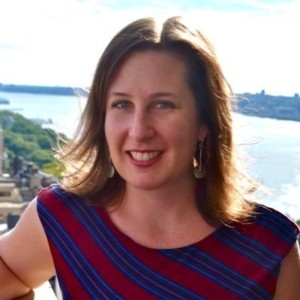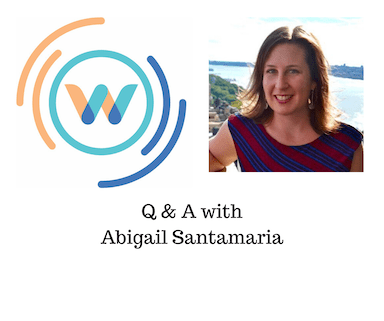L’Engle biographer, conference speaker is working on a ‘thorough, fully-sourced portrait’
Fans could be forgiven for feeling as if they personally know Madeleine L’Engle. Maybe their bookshelves are lined with a trove of her non-fiction titles; maybe the voices and characters from L’Engle’s fiction books are stuck in their minds. We fans may even have read Becoming Madeleine: A Biography of the Author of a Wrinkle in Time by Her Granddaughters and A Light So Lovely: The Spiritual Legacy of Madeleine L’Engle. “Quiz us,” we fans might say.
But a biographer — now there’s someone whose job it is to introduce us to a person in a new way. Biography is an art form, for sure, and one we’ll be talking about during the third round of breakout sessions at the Madeleine L’Engle conference, Walking on Water.
Two biographers will converse during the session (Writing a Writer’s Life: The Art of Biography): Madeleine L’Engle’s biographer Abigail Santamaria and Mary Oliver’s biographer Lindsay Whalen. Specifically, we’ll be able to hear them talk about the unique challenges of writing about artists, and why the works and lives of these two major 20th-century American women writers continue to resonate.
Before we get into that topic, though, we asked Abigail to go autobiographical for a second. Let’s get to know her better!

Abigail Santamaria
What excites you about the Madeleine L’Engle Conference?
Abigail Santamaria: Professionally, as Madeleine L’Engle’s biographer, I’m excited to meet so many people who knew her. I would love to hear stories, memories, thoughts and insights about Madeleine’s life and work from all who are willing to contribute. To those who knew her: please introduce yourselves! If there’s not time to chat during the conference weekend, I’d love to exchange contact information.
Personally, while I’m looking forward to the full menu of offerings I’m most excited about hearing Katherine Paterson, one of the hero authors of my adolescence. I vividly remember reading Bridge to Terabithia in my childhood canopy bed, tears streaming down my cheeks; I couldn’t believe I was crying over a book. For the first time, I consciously understood that books were capable of eliciting profound emotional responses. That was a foundational experience.
Do you have a Madeleine story/quote/moment that has inspired you?
Abigail Santamaria: Oh boy–choosing one means leaving out so many others! But here is one — not necessarily THE most inspirational, but this bit of dialogue from L’Engle’s Camilla has affirmed my proclivity for risk-taking, even when those risks wrought unbearable waves of insecurity:
“No such thing as security. Doesn’t exist. Only a feeling of security.”
“Then I’d like to have that feeling.”
“No, Camilla, not really. If you were secure, things wouldn’t change, would they?”
“I guess not.”
“Without change — uncertainty, fear that goes with it — we wouldn’t be.”
“What do you mean? Why not?”
“In order to be, honey, we must progress. Once we stop moving, we die. In order to progress, we must change… Life is the greatest of all arguments for insecurity.”
In what ways does a legacy like Madeleine’s inspire the way you create art for a new generation?
Abigail Santamaria: Another tough one. My answer to this changes frequently depending on what book(s) of Madeleine’s I’m reading or what particular aspect/period of her life I’m researching.
What are you working on now?
Abigail Santamaria: My big years-long current project is the first adult biography of Madeleine L’Engle, which will be published by Farrar, Straus & Giroux. The book will be a thorough, fully-sourced portrait — a prodigious task. Madeleine led a long, rich life full of friends, family, and fans with whom she corresponded at length; full of long solitary journal-writing sessions; full of lectures, sermons, interviews. And she came from a family that saved nearly everything, from letters to journals to sermon audio. Her paper-trail is more like a vast network of all terrain trails. (To give you a sense of the level of minutiae in her archive: I found a pre-Civil War grocery receipt, dated nearly 60 years before Madeleine’s birth in 1918.)
And because Madeleine is so contemporary, there are loads of people to interview. This fall I’m working on a secret special smaller Madeleine project, which I can’t talk about publicly until spring. Stay tuned! It’s a good one. In addition to my own writing projects, I co-own (with the brilliant Kate Buford) a business called Biography by Design, which specializes in privately contracted biographies, family histories, memoirs, corporate histories, and histories of non-profits and other organizations. We also provide services including ghostwriting, manuscript editing, research and nonfiction book proposal consultations.
***
One more bonus: You can read an excerpt from her first biography, Joy: Poet, Seeker, and the Woman Who Captivated C.S. Lewis.
For more about Lindsay Whalen, check out this essay, written just after Mary Oliver’s death. Whalen’s book about Oliver is forthcoming from Penguin Press.
The two women certainly have interesting things to share about a couple of our favorite authors! Can’t wait to hear at the conference, Nov. 16 in NYC! Until then —
Tesser well,
Erin F. Wasinger for MadeleineLEngle.com.



